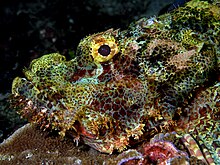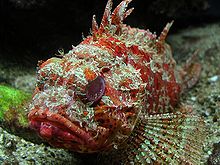| Scorpionfish | |
|---|---|

| |
| Scorpaenopsis oxycephala | |
| Scientific classification | |
| Domain: | Eukaryota |
| Kingdom: | Animalia |
| Phylum: | Chordata |
| Class: | Actinopterygii |
| Order: | Perciformes |
| Suborder: | Scorpaenoidei |
| Family: | Scorpaenidae A. Risso, 1826 |
| Type species | |
| Scorpaena porcus Linnaeus, 1758 | |
| Subfamilies | |
|
See text | |

The Scorpaenidae (also known as scorpionfish) are a family of mostly marine fish that includes many of the world's most venomous species. As their name suggests, scorpionfish have a type of "sting" in the form of sharp spines coated with venomous mucus. The family is a large one, with hundreds of members. They are widespread in tropical and temperate seas but mostly found in the Indo-Pacific. They should not be confused with the cabezones, of the genus Scorpaenichthys, which belong to a separate, though related, family, Cottidae.
Taxonomy
Scorpaenidae was described as a family in 1826 by the French naturalist Antoine Risso. The family is included in the suborder Scorpaenoidei of the order Scorpaeniformes in the 5th Edition of Fishes of the World but other authorities place it in the Perciformes either in the suborder Scorpaenoidei or the superfamily Scorpaenoidea. The subfamilies of this family are treated as valid families by some authorities.
Subfamilies and tribes
Scorpaenidae is divided into the following subfamilies and tribes, containing a total of 65 genera with no less than 454 species:
- Subfamily Sebastinae Kaup, 1873 (Rockfishes)
- Tribe Sebastini Kaup, 1873
- Tribe Sebastolobini Matsubara, 1943
- Subfamily Setarchinae Matsubara, 1943
- Subfamily Neosebastinae Matsubara, 1943
- Subfamily Scorpaeninae Risso, 1826 (Scorpionfishes and lionfishes)
- Tribe Scorpaenini Risso, 1826
- Tribe Pteroini Kaup, 1873
- Subfamily Caracanthinae Gill, 1885 (Orbicular velvetfishes or coral crouchers)
- Subfamily Apistinae Gill, 1859
- Subfamily Tetraroginae J.L.B. Smith, 1949 (Sailback scorpionfishes or wasp fishes)
- Subfamily Synanceiinae Swainson, 1839 (Stonefishes)
- Tribe Minoini Jordan & Starks, 1904
- Tribe Choridactylini Kaup, 1859
- Tribe Synanceiini Swainson 1839
- Subfamily Plectrogeniinae Fowler, 1938
Characteristics
Scorpaenidae have a compressed body with the head typically having ridges and spines. There are 1–2 spines on the operculum, with 2 normally being divergent, and 3–5 on the preoperculum, normally 5. The suborbital stay is normally securely attached to the preoperculum, although in some species it may not be attached. If there are scales they are typically ctenoid. They normally have a single dorsal fin which is frequently incised. The dorsal fin contains between 11 and 17 spines and 8 and 17 soft rays while the anal fin usually has between 1 and 3 spines, normally 3, and 3 to 9 soft rays, typically 5, There is a single spine in the pelvic fin and between 2 and 5 soft rays, again typically 5, while the large pectoral fin contains 11–25 soft rays and sometimes has a few of the lower rays free of its membrane. The gill membranes are not attached to the isthmus. In some species, there is no swim bladder. There are venom glands in the spines of the dorsal, anal, and pelvic fins in some species. Most species utilise internal fertilisation, and some species are ovoviviparous while others lay their eggs in a gelatinous mass, with Scorpaena guttata being reported to create a gelatinous "egg balloon" as large as 20 cm (7.9 in) across. The largest species is the shortraker rockfish (Sebastes borealis) which attains a maximum total length of 108 cm (43 in) while many species have maximum total lengths of 5 cm (2.0 in).
Distribution and habitat
Scorpaenidae species are mainly found in the Pacific and Indian Oceans, but some species are also found in the Atlantic Ocean. Some species such as the lionfishes in the genus Pterois are invasive non native species in areas such as the Caribbean and the eastern Mediterranean Sea. They are found in marine and brackish habitats. They typically inhabit reefs, but can also be found in estuaries, bays, and lagoons.
References
- ^ Richard van der Laan; William N. Eschmeyer & Ronald Fricke (2014). "Family-group names of Recent fishes". Zootaxa. 3882 (2): 001–230. doi:10.11646/zootaxa.3882.1.1. PMID 25543675.
- ^ J. S. Nelson; T. C. Grande; M. V. H. Wilson (2016). Fishes of the World (5th ed.). Wiley. pp. 468–475. ISBN 978-1-118-34233-6.
- ^ Ricardo Betancur-R; Edward O. Wiley; Gloria Arratia; et al. (2017). "Phylogenetic classification of bony fishes". BMC Evolutionary Biology. 17 (162): 162. Bibcode:2017BMCEE..17..162B. doi:10.1186/s12862-017-0958-3. PMC 5501477. PMID 28683774.
- Hisashi Imamura (2004). "Phylogenetic Relationships and New Classification of the Superfamily Scorpaenoidea (Actinopterygii: Perciformes)". Species Diversity. 9: 1–36. doi:10.12782/specdiv.9.1.
- ^ Froese, Rainer; Pauly, Daniel (eds.). "Family Scorpaenidae". FishBase. June 2021 version.
- Froese, Rainer; Pauly, Daniel (eds.). "Family Sebastidae". FishBase. June 2021 version.
- Hamner, R. M.; Freshwater, D. W.; Whitfield, P. E. (2007). "Mitochondrial cytochrome b analysis reveals two invasive lionfish species with strong founder effects in the western Atlantic". Journal of Fish Biology. 71: 214–222. Bibcode:2007JFBio..71S.214H. doi:10.1111/j.1095-8649.2007.01575.x.
- Weisberger, Mindy (28 June 2016). "Aliens Attack! Invasive Lionfish Arrive in Mediterranean". livescience.com. Retrieved 13 February 2020.
Further reading
- Doubilet, David (November 1987). "Scorpionfish: Danger in Disguise". National Geographic. Vol. 172, no. 5. pp. 634–643. ISSN 0027-9358. OCLC 643483454.
External links
- Scorpaenidae entry on the Animal Diversity Web.
- Scorpionfish Rescue - Koh Phangan, Thailand